Market
Sotheby’s and a Former Banksy Dealer Team Up to Test the Market for Street-Artist Rammellzee in London
Are blue-chip collectors ready for Rammellzee's mythical brand of Afrofuturism?
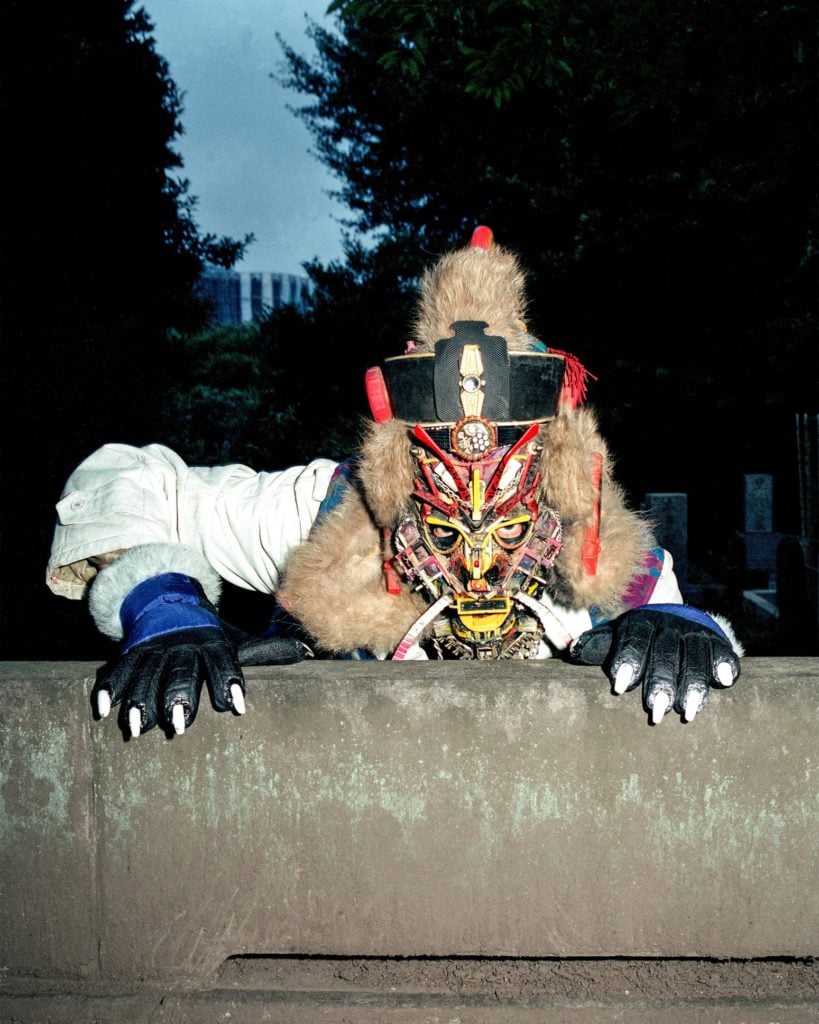
Are blue-chip collectors ready for Rammellzee's mythical brand of Afrofuturism?

Sarah Cascone

If Sotheby’s has its way, the compelling and mysterious Rammellzee (1960–2010), a graffiti artist, sculptor, hip-hop musician, and cult figure, will soon become a blue-chip artist. The auction house, which represents his estate, will team up with former Banksy dealer Steve Lazarides to stage a selling exhibition of Rammellzee’s work this fall, with an eye toward building up a market for the unconventional figure.
Rammellzee’s work is a reflection of his personal cosmology and manifesto, “Gothic Futurism,” which imagined a world where letters were free of the power structures of language, becoming objects in their own right. As a mainstay of the New York graffiti scene—Rammellzee collaborated with Jean-Michel Basquiat and rapped in the classic 1983 hip hop film Wild Style—he was influenced by the increasingly ornate lettering employed by street artists, as well as the medieval manuscripts hand-lettered by monks.
It’s unclear how Rammellzee would have felt about this latest development in his legacy. An enigmatic recluse, he adopted his mathematical moniker in 1979—it’s technically an equation—and never revealed his birth name. And he made no effort to court the establishment during his lifetime.
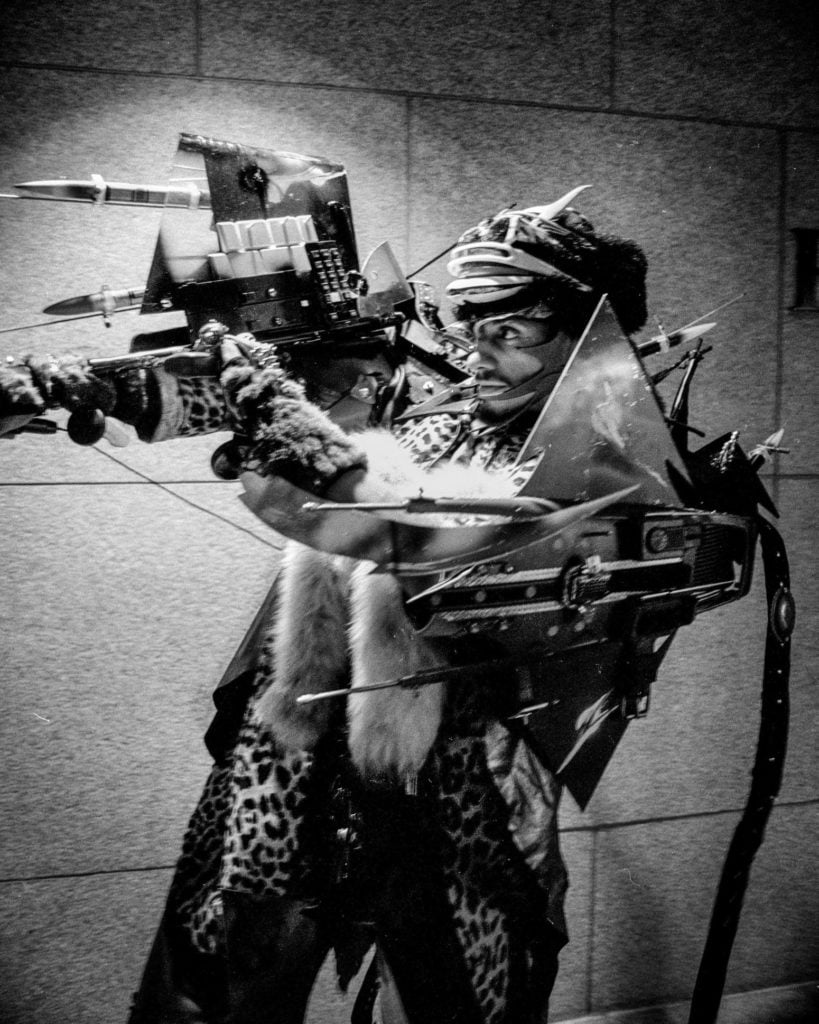
Rammellzee, Hip-hop ’til you drop performance at the Whitney Museum of American Art, New York, (1989). Photo by Brian Williams, courtesy of Red Bull Arts New York.
“He was creating this visionary Afrofuturist universe, but it was private work and not for sale,” art critic and street art expert Carlo McCormick told the Art Newspaper, which first reported the planned sale. Together with Max Wolf, McCormick organized the exhibition “RAMMΣLLZΣΣ: Racing for Thunder,” currently on view at Red Bull Arts New York.
Unlike the upcoming London show, nothing is available for purchase at Red Bull Arts, which is a non-selling, non-collecting outfit. The exhibition does, however, include loans from Sotheby’s, which began representing the estate about a year ago, while Red Bull Arts was working on the show.
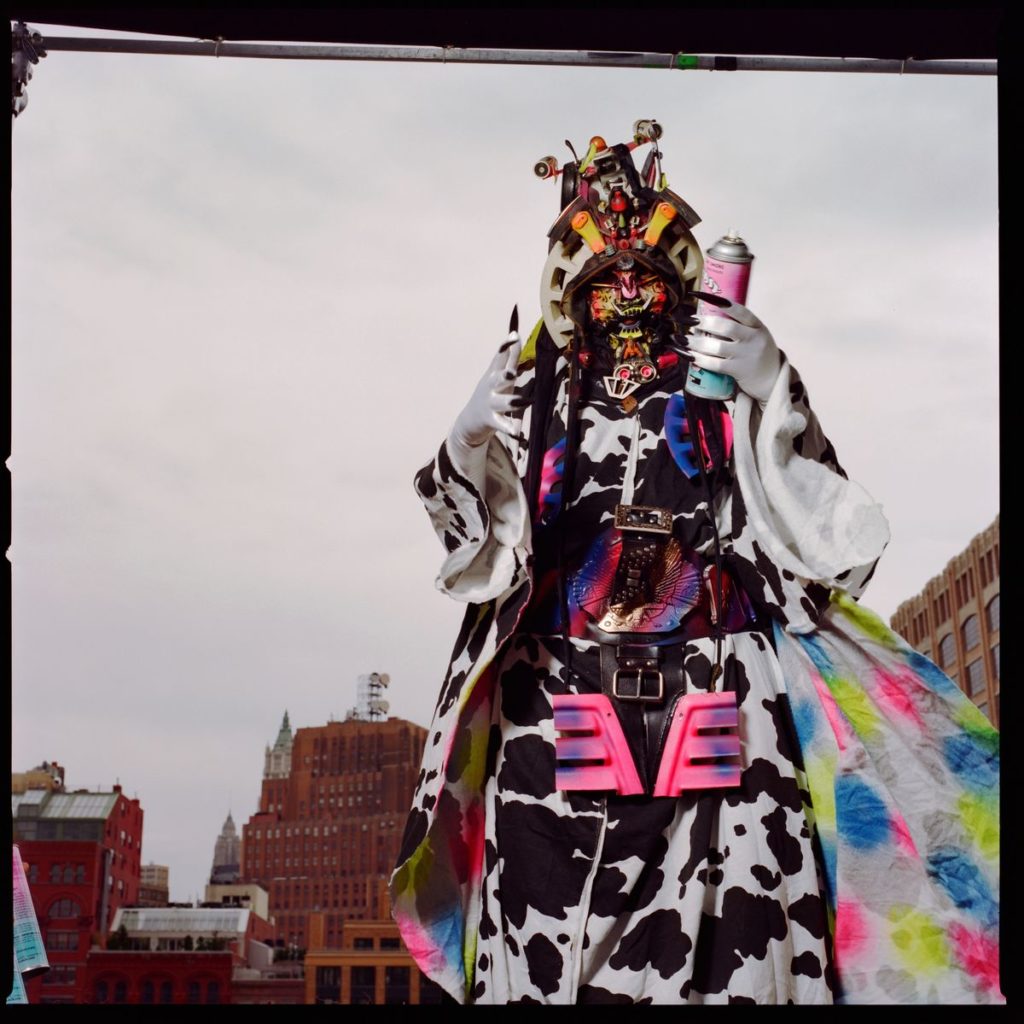
Rammellzee as “Crux the Monk” (2002). Photo by Keetja Allard, courtesy of Red Bull Arts New York.
Lazarides has timed the artist’s first major UK exhibition, where prices will range from £30,000 ($38,267) to £350,000 ($446,466), to the Frieze Art Fair in October. Held at his Mayfair gallery Lazinc, “Rammellzee: A Roll of the Dice” will feature an estimated five works from Sotheby’s as well as loans from private European collections, including examples of Rammellzee’s large-scale epoxy resin sculptures. (It was the toxic fumes from the creation of those works that were partially responsible for the Rammellzee’s poor health and premature death at just 59.)
According to the artnet Price Database, Rammellzee’s record at auction is €117,000 ($137,162), set in December at Artcurial in Paris for How to Make a Bomb, a 1985 spray paint and collage piece. He has topped $60,000 just six times at auction, but four of those sales took place this year, perhaps indicating a market on the rise. However, all of his major sales have been for 2-D works, with just one sculpture, a 36-inch-long mixed media car, hammering down at $2,500 back in 2006.

Rammellzee, How to Make a Bomb. This became the artist’s most expensive piece at auction when it sold for €117,000 ($137,162) in December, Courtesy of Artcurial.
Rammellzee’s second biggest auction sale—of 26 “Wild Style Letter” paintings of each letter of the alphabet—was £87,500 ($109,265) at Phillips London last April. That series was originally sold at New York’s Suzanne Geiss Company, during the 2012 exhibition “Rammellzee: The Equation, the Letter Racers.”
Suzanne Geiss was the estate’s previous representative, and the Rammellzee exhibition was her gallery’s inaugural show. The year before, Geiss’s former boss Jeffrey Deitch included a recreation of the Battle Station—Rammellzee’s notorious Tribeca loft and studio—in “Art in the Streets,” a graffiti survey at the Museum of Contemporary Art, Los Angeles, where he was then director.
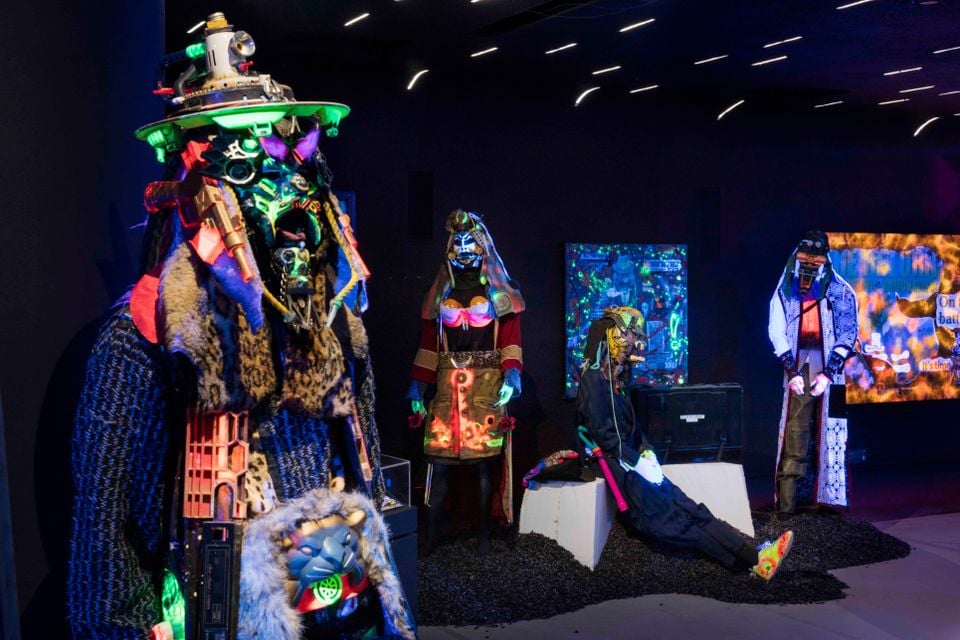
Exhibition view of “RAMMΣLLZΣΣ: Racing for Thunder” at Red Bull Arts New York. Photo courtesy of Red Bull Arts New York
The New York Times wrote that Geiss’s efforts were helping “reshape the reputation of an artist regarded by the established art world during most of his life with more bemused curiosity and confusion than serious interest.” But then the artist’s widow, Carmela Zagari, died in 2012, in an accident that may have been caused by a falling bookshelf.
Zagari’s sister now handles the estate, which mainly comprises work created during the last 15 years of Rammellzee’s life, when he increasingly remained in the Battle Station. “He shut himself away from the world of money and power,” Geiss told Dazed in 2012.
It was Geiss who first attempted to sort through the art Rammellzee left behind. He was forced to downgrade to a smaller apartment in Battery Park City following the 9/11 attacks, after the building that housed the Battle Station was sold. As a result, much of his work went into storage where it largely remained, unseen by the public.
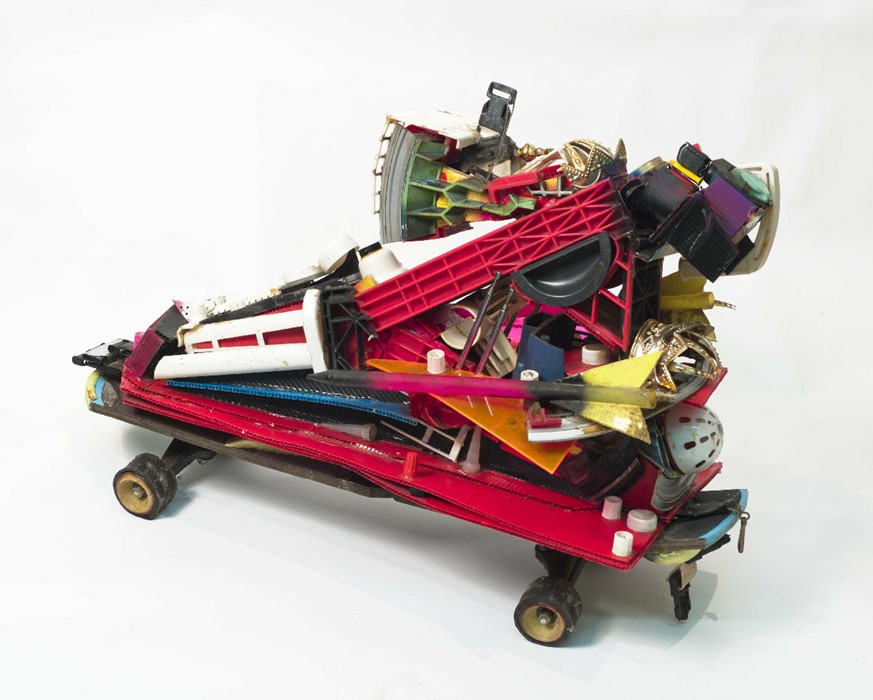
Rammellzee, Letter Racers (detail). Photo courtesy of the artist’s estate.
“I can’t imagine what others might have thought opening the storage unit—like, what is this pile of junk?” Geiss told the Red Bull Bulletin. “He’d had a deep fryer at the Battle Station, so everything was coated in this residue of grease. We moved it all to a warehouse and spent seven months cleaning and cataloging it. It was like an archaeological excavation.”
Despite her efforts, by the time Red Bull got involved, “the estate was a real mess,” according to McCormick.
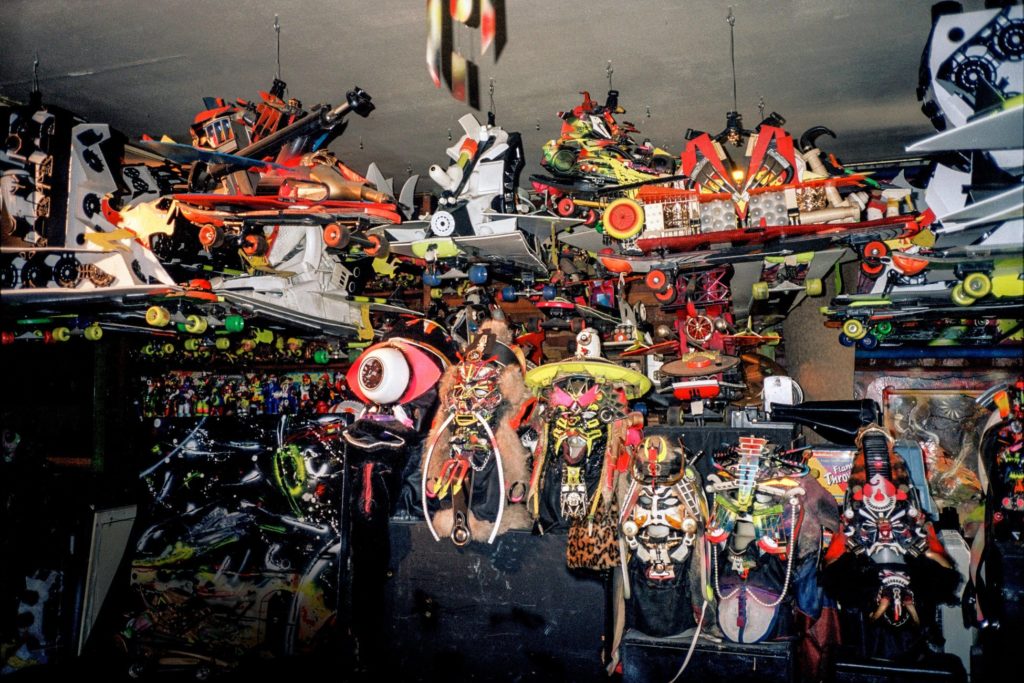
Rammellzee’s studio, the Battle Station. Photo by Angela Boatwright, courtesy of Red Bull Fine Arts.
The current survey exhibition is the artist’s largest show to date. Though visionary, Rammellzee’s work can be challenging in its scale for the would-be collector. There are his “Letter Racers” bricolage sculptures, skateboards-turned-battleships made in the form of each letter of the alphabet. Made from assorted trash, such as birth control packaging and Old English bottle caps—Rammellzee’s favorite drink—the battalion is outfitted with would-be jetpacks.
His oeuvre includes cosmic-looking, psychedelic-colored paintings but also massive “Garbage Gods” sculptures, robotic suits of armor crafted from garbage. He would sometimes wear the suits on the city streets, shooting sparks from his fingertips. One, Gasholeer, even had a flamethrower.
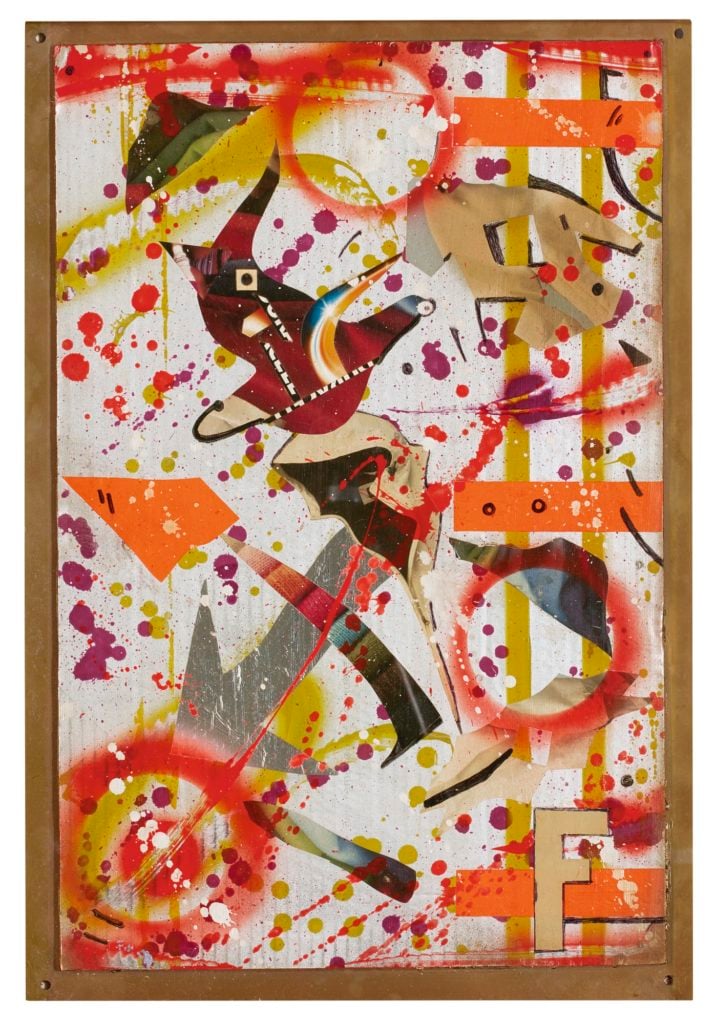
Rammellzee, Atomic Note Farenheit (circa 1990). Courtesy of Sotheby’s.
So far, Sotheby’s has had mixed results with its sales from the Rammellzee estate, which have all featured more accessible 2-D paintings. In March, Atomic Note Fahrenheit (circa 1990) failed to find a buyer on an estimate of $50,000–70,000. Knotted Minds, from the same year, sold for $47,500 last September, currently Rammellzee’s 10th biggest number on the block. A 2004 collage, Love for You, fetched $20,000 on a high estimate of $8,000 at an online auction that month.
At the time, Sotheby’s called Rammellzee “one of the most iconoclastic and influential artists of his time,” praising his “astonishingly varied and influential body of work.” They’ve since played up the Basquiat connection, proclaiming that “Before Basquiat—There Was Rammellzee.” How well that will play with major collectors remains to be seen.
“RAMMΣLLZΣΣ: Racing for Thunder” is on view at Red Bull Arts New York, 220 West 18th Street, New York, May 4–August 26, 2018.
“Rammellzee: A Roll of the Dice” will be on view at Lazinc, 29 Sackville Street, Mayfair, London, October 2–November 10, 2018.